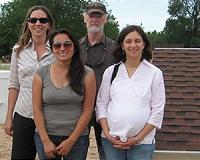| . |  |
. |
Copenhagen, Denmark (SPX) Mar 21, 2011 Radioactive waste decaying down at the dump needs millions of years to stabilize. The element Neptunium, a waste product from uranium reactors, could pose an especially serious health risk should it ever seep its way into groundwater - even 5 million years after its deposition. Now, researchers at the University of Copenhagen have shown the hazardous waste can be captured and contained. The means? A particular kind of green goop that occurs naturally in oxygen-poor water. Bo C. Christiansen is a geochemist at the University of Copenhagen who specializes in "green rust". In a recent article published in the prestigious journal Geochimica et Cosmochimica Acta, Christiansen describes how green rust is able to, so to say, encapsulate and contain neptunium. It's an insight that can greatly influence how and where to dispose of radioactive waste. "Our study shows that even the safest encapsulation of radioactive waste could be made safer if radioactive waste canisters are buried in a place where green rust will form," explains Christiansen. For years green rust was perceived as a problem. The substance was investigated primarily by material scientists who wanted to know how to avoid green rust formation in reinforced concrete. In recent years however, a group of chemists, physicists and geologists at the Department of Chemistry's Nano-Geoscience Research Group have been studying the substance's beneficial properties. The results have exceeded all expectations. "Neptunium is a relatively exotic problem. Not a lot of people need to safeguard a radioactive waste depot. But green rust appears to be effective against nearly any kind of pollution," says Bo Christiansen. Green rust is a type of clay referred to as an anionic clay. Because it consists of iron which has not entirely rusted, green rust has an electron deficit. This makes it react very readily with other pollutants, some of which are quite prevalent. "A while ago we showed how green rust can react with the carcinogenic chromium (6) and convert it to chromium (3). "Besides being non-toxic, chromium (3) is one of the trace elements that the human body needs," says Christiansen. Large quantities of green rust are rarely present at any given moment due to it's very high level of reactivity. On the other hand, it's easy to make. Green rust will form if iron sulphate and caustic soda are present in water. But it won't last long. As soon as oxygen is added to the mix, the rust will become ordinary red rust, known by its ochre characteristics. Experiments demonstrating green rust's ability to immobilize neptunium have been conducted partly at SKB - Swedish Nuclear Fuel and Waste Management's full scale pilot research facility at Okskarshamn on the Swedish east coast and also in part at the Karlsruhe Institute of Technology in Germany. Typically, radioactive waste is disposed of in iron-lined copper canisters. This is suitable as long as the canisters are surrounded by water. However, any future ice-age will draw water levels downwards. Should the copper dry, it will begin to decay. And as the copper disappears, it will only take a short time for the iron to begin rusting away. Ultimately, the radioactive waste gains entry to the groundwater. Therefore, to ensure the security of radioactive waste, green rust could be established to surround the canisters. "Green rust is no quick-fix to clean up after pollution that suddenly presents itself. But our experiments have shown the surprising result that nature can help to clean itself. Even when the pollution is with a substance as serious as neptunium," says Bo Christiansen who expects the results to inform and be applied to the design and modeling of future radioactive storage.
Share This Article With Planet Earth
Related Links University of Copenhagen Water News - Science, Technology and Politics
 Rainwater Harvesting
Rainwater HarvestingAustin TX (SPX) Mar 09, 2011 For the past few years, one of the most common questions facing the Texas Water Development Board (TWDB) hasn't been over contentious water rights or proposed water projects; it's been from homeowners wanting to know what type of roofing material is most suitable for collecting rainwater for indoor domestic use. "Rainwater harvesting is becoming fairly widespread, at least in Central Texas ... read more |
|
| The content herein, unless otherwise known to be public domain, are Copyright 1995-2010 - SpaceDaily. AFP and UPI Wire Stories are copyright Agence France-Presse and United Press International. ESA Portal Reports are copyright European Space Agency. All NASA sourced material is public domain. Additional copyrights may apply in whole or part to other bona fide parties. Advertising does not imply endorsement,agreement or approval of any opinions, statements or information provided by SpaceDaily on any Web page published or hosted by SpaceDaily. Privacy Statement |